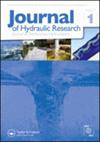湍流和层流条件下堤坝下方管道的侵蚀时间尺度
IF 1.7
3区 工程技术
Q3 ENGINEERING, CIVIL
引用次数: 0
摘要
摘要本文讨论了管道侵蚀时间,即管道在堤坝下的含水层中开始侵蚀,直到达到临界值。管道侵蚀时间的大小在很大程度上决定了水防御系统失效的风险。时间尺度方程基于泥沙平衡方程和适当的推移质输运预测因子,假设侵蚀过程是连续的。我们认为,沙质含水层中的管道流动是层流,砾石含水层中管道流动是湍流。然后,我们通过讨论每个流态的不同推移质输送预测因子,在检查管道侵蚀时考虑含水层成分。为了估计湍流强度,我们使用并修改了爱因斯坦推移质输运理论。时间尺度关系包括曲流弯曲的影响,并已在小尺度和大尺度的一些实验中进行了测试。本文章由计算机程序翻译,如有差异,请以英文原文为准。
Erosion time scale in pipes below dikes for turbulent and laminar flow
ABSTRACT This article discusses the piping erosion time, where pipes start to erode in aquifers underneath dikes and dams until they reach their critical values. The magnitude of the piping erosion time significantly determines the risk of failure of water defences. The time-scale equation is based on a sediment mass balance equation and appropriate bedload transport predictors, assuming the erosion process to be continuous. We argue that the flow is laminar for pipes in sandy aquifers and turbulent for pipes in gravel aquifers. We then account for aquifer composition in examining pipe erosion by discussing different bedload transport predictors for each flow regime. To estimate the turbulence intensity, we have used and modified the Einstein bedload transport theory. The time-scale relation includes the effects of meander bends and has been tested for some experiments on a small scale and on a large scale.
求助全文
通过发布文献求助,成功后即可免费获取论文全文。
去求助
来源期刊

Journal of Hydraulic Research
工程技术-工程:土木
CiteScore
4.90
自引率
4.30%
发文量
55
审稿时长
6.6 months
期刊介绍:
The Journal of Hydraulic Research (JHR) is the flagship journal of the International Association for Hydro-Environment Engineering and Research (IAHR). It publishes research papers in theoretical, experimental and computational hydraulics and fluid mechanics, particularly relating to rivers, lakes, estuaries, coasts, constructed waterways, and some internal flows such as pipe flows. To reflect current tendencies in water research, outcomes of interdisciplinary hydro-environment studies with a strong fluid mechanical component are especially invited. Although the preference is given to the fundamental issues, the papers focusing on important unconventional or emerging applications of broad interest are also welcome.
 求助内容:
求助内容: 应助结果提醒方式:
应助结果提醒方式:


